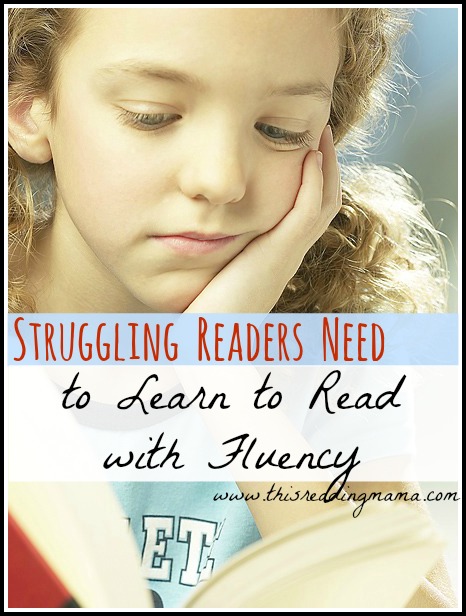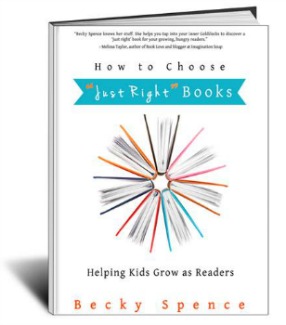Over the last few weeks, I’ve been posting about struggling readers. If this is your first time joining me, WELCOME! To get caught up, click HERE or on the image above and you can read the background and the topics we’ve covered thus far.
*This post may contain affiliate links. To learn more about this, please read my disclosure policy.
Struggling Readers and Fluency
Today we’re going to focus on how struggling readers need to learn to read with fluency. The last three topics we’ve covered directly relate to reading with fluency. How? You might ask. Let me break it down:
- Books they Can Read– It’s extremely hard (or near impossible) to read with fluency when you can’t read or decode most of the words, since a large part of reading with fluency is being able to quickly recognize words. Calkins says in The Art of Teaching Reading, “A child who has problems with fluency often reflects the accumulated experience of reading at frustration level. Our first intervention will be to make certain that this child is on steady course of books he can read with ease.” (170)
- Books they Want to Read– Struggling readers are more likely to persist in reading when their motivation is high. It’s hard to get motivated if you are consistently reading books that may be on your reading level, but are “baby-ish” or uninteresting to you.
- Uninterrupted Blocks of Time– Fluent reading doesn’t come through worksheets, drills, and elaborate lectures. Kids need time to practice and kids need uninterrupted reading time to do just this.
 {photo credit}
{photo credit}
Problems with Fluency
Why do some readers have fluency problems? While it varies from child to child, here are a few ideas to chew on.
- I’m not trying to sound redundant, but struggling readers may not have a steady diet of books they can read, books they want to read, or uninterrupted blocks of time to read.
- Phonics Skills: Most of the students I tutor(ed) 1-are missing some foundational phonics skills, making it difficult to decode or read word patterns, or 2- have difficulty applying their phonics knowledge to real reading. That’s why I am such a big fan of Word Study. By having them spell a few words from the Primary Spelling Inventory, I am able to see exactly which phonics skills they may be missing. The word sorts and accompanying activities allow me to spend short amounts of time on the phonics skills in isolation to leave time for real reading and application of those skills.
- I’ve also noticed that many times disfluent reading happens because these readers are not confident with their sight words. Sight words make up about 50% of what we read, so they are a necessary part of learning to read with fluency.
- Gay Su Pinnell, another great reading researcher, makes another observation that students have been taught to finger-point as they read, which leads to exaggerated pauses in between words. She suggests to encourage students to only use their finger if they encounter difficulty. (pg. 347-The Art of Teaching Reading)
What Can you Do for a Disfluent Reader? Just a few resources…
- Authentic activities for fluency
- Sight Word Games (you can find a lot on my Pinterest board!)
- The Teaching of Sight Words
- 10 Days of Teaching Word Study (learning word patterns)
- Lucy Calkins gives these suggestions of things to say to a disfluent reader: (pg. 115 of The Art of Teaching Reading)
- Can you put your words together, say it quickly?
- Say it as if you’re talking.
- Look at me. Say it to me as if we’re talking. Try to read like that.
- Listen to me read it and copy me. (model fluent reading)
- Can you read it again and help me really feel what is happening in the story?
Why is fluency important?
The ultimate goal of fluency isn’t to “attain faster, more fluent oral reading. The goal is improved comprehension of the material read and…improved reading confidence.” (pg. 99 of What Really Matters for Struggling Readers)
Quick examples of how fluency is related to comprehension:
- If a child is not using correct phrasing while reading, it is a sign to me that the child is not comprehending the text on a basic level. (And when sentences run together, the text can take on a whole new meaning.)
- With older readers, passages of texts get longer and longer. If a reader isn’t able to read the passage in a timely manner, it may be near impossible to remember what she read 20 minutes ago from the previous page; negatively affecting comprehension.
No doubt about it, fluency is a vital part of comprehension. All readers need to learn to read with fluency, but it is an especially important thing for our struggling readers.
For a list of fluency behaviors and checklists as you listen to young readers read aloud, you’ll find them in my ebook, How to Choose “Just Right” Books.
~Becky


Thank you so very much for your accolades. I have been retired since 2003. So, I haven’t added anything to my website since then. In fact I am so pleased that someone found my site and told me I can keep it up for free. I had intended to take it down.
A blog! How very nice. I would love to contribute if I could. Haven’t thought about education in a while, but I know I certaintly miss it…terribly!
I’m so glad to hear back from you…and so soon. I’d love to keep in contact to see what we could work out! Thanks for the comment.
Becky,
I think I know the answer to this, but sometimes I am just not sure. My school just purchased a new ELA curriculum and I will be helping the fifth grade teachers administer a one-minute ORF assessment to the students that scored below grade level on the STAR. Should these students read/test on a beginning of 5th grade passage to determine their initial fluency ability, or if a student scored a 3.5 should that student read a passage at a middle of 3rd grade level?